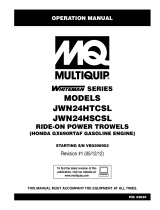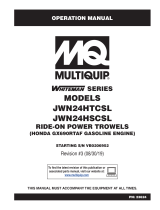Page is loading ...

InstructionDisclaimer
Dennis Kirk provides instructions to help our customers better understand how to install the
products we sell. The instructions are exact copies of what the manufacturer includes with the
product being sold.
That means the quality and accuracy of the instructions is solely dependent on what the
manufacturer produces. We do our best to make the text legible and the pictures viewable.
However, the end result depends largely on the quality of instructions the manufacturer
provides.
Therefore, you will find that some instructions are not of the highest quality. Sometimes text is
hard to read and pictures are not easy to see. At times you will find the overall look of the
instructions to be less than professional. However, we feel it is better to provide what we have
rather than provide nothing at all.
To the best of our knowledge the instructions and application information contained in the
instructions is accurate. However, Dennis Kirk assumes no liability related to any errors that
may be contained in the copy of the manufacturer’s instructions we provide. Buyers are solely
responsible to insure that product use is consistent with their application.
If you have any questions please contact us at [email protected]
or
800-969-7501 so we can further assist you regarding additional product information or any other
business related questions.
Thank you for doing business with Dennis Kirk.

To ensure optimal operation of newly installed belts, the CVT
sheaves must be cleaned of all old belt residue, glazing, and
oils. Cleaning can be accomplished by carefully scuffing belt
contaminates off the sheave/belt contact area with a mild
abrasive such as 220-400grit sandpaper, Scotch Brite Pad,
or Steel Wool. Follow up by cleaning the surfaces thoroughly
with soapy water and or brake cleaner until all impurities
have been removed. Cleaning the sheave surface until all
contaminates have been removed is vital to future belt
and CVT operation. If any particles remain, belt slip and a
noticeable drop in vehicle performance can occur. If a belt is
to be removed and reinstalled during future maintenance, it is
highly recommended that the belt is reinstalled in the same
direction as before to match belt wear profile to contact with
the corresponding sheave profile.
GATES G-FORCE® CVT BELT INSTALLATION
Dirty Sheave Plates
Clean Sheave Plates
Dirty Sheaves should be
cleaned with a mild abrasive to
remove rubber and other wear
contaminates as shown above by
dirty Sheave. Dark wear patterns
must be removed from the surface
then cleaned off with an alcohol
agent or brake cleaner to remove
fine particulates.

GATES CORPORATION <> WORLD HEADQUARTERS
1551 Wewatta Street / P.O. Box 5887
Denver, Colorado 80202, U.S.A.
303.744.1911
Gates.com
GATES CANADA INC.
225 Henry St. Bldg. 8
Brantford, Ontario N3S 7R4
1.519.759.4141
New Belt Break In Process:
New CVT drive belts require a break-in period of at minimum 30
miles to maximize belt life and performance. The goal of the
break-in period is to properly wear in the belt to match the sheaves
before applying maximum engine torque. By conservatively running
through the entire shift range, proper belt contact over the entire
sheave/belt contact path is optimized to eliminate belt slippage and
drastically increase the belt’s lifespan.
Follow these guidelines to accomplish proper Belt-Break in:
› Vary vehicle speed and engine RPM to shift belt through normal
operational range.
› Do not exceed ¾ throttle within the first 30 miles of installation.
› Stop engine and allow belt to cool down every 15 minutes of use.
During break-in period, the following activities SHOULD BE AVOIDED:
› Aggressive Acceleration or ‘Jerky’ throttle movements at
low speeds.
› Holding engine/vehicle speed constant for extended
time periods.
› Pulling Heavy Loads.
› Long run times without complete CVT/belt cool down.
By following the break-in process carefully, the belt surface will
wear in to match the individual CVT sheaves to maximize grip
performance and dramatically reduce heat, glazing, and future wear.
/







